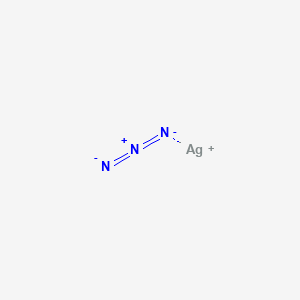Silver azide
- SILVER AZIDE
- Silver monoazide
- Silver(1+) azide
- 13863-88-2
- Silver azide (dry)
- Create:2005-08-08
- Modify:2025-01-18




H200 (100%): (Deleted) Unstable Explosive [Danger Explosives]
H300+H310+H330 (50%): Fatal if swallowed, in contact with skin or if inhaled [Danger Acute toxicity, oral; acute toxicity, dermal; acute toxicity, inhalation]
H300 (50%): Fatal if swallowed [Danger Acute toxicity, oral]
H310 (50%): Fatal in contact with skin [Danger Acute toxicity, dermal]
H330 (50%): Fatal if inhaled [Danger Acute toxicity, inhalation]
H400 (50%): Very toxic to aquatic life [Warning Hazardous to the aquatic environment, acute hazard]
H410 (50%): Very toxic to aquatic life with long lasting effects [Warning Hazardous to the aquatic environment, long-term hazard]
P201, P202, P260, P262, P264, P270, P271, P273, P280, P281, P284, P301+P316, P302+P352, P304+P340, P316, P320, P321, P330, P361+P364, P372, P373, P380, P391, P401, P403+P233, P405, and P501
(The corresponding statement to each P-code can be found at the GHS Classification page.)
Aggregated GHS information provided per 6 reports by companies from 2 notifications to the ECHA C&L Inventory. Each notification may be associated with multiple companies.
Information may vary between notifications depending on impurities, additives, and other factors. The percentage value in parenthesis indicates the notified classification ratio from companies that provide hazard codes. Only hazard codes with percentage values above 10% are shown.
Unst. Expl. (100%)
Acute Tox. 2 (50%)
Acute Tox. 2 (50%)
Acute Tox. 1 (50%)
Aquatic Acute 1 (50%)
Aquatic Chronic 1 (50%)
Patents are available for this chemical structure:
https://patentscope.wipo.int/search/en/result.jsf?inchikey=QBFXQJXHEPIJKW-UHFFFAOYSA-N
- Australian Industrial Chemicals Introduction Scheme (AICIS)Silver azide (Ag(N3))https://services.industrialchemicals.gov.au/search-inventory/
- CAS Common ChemistryLICENSEThe data from CAS Common Chemistry is provided under a CC-BY-NC 4.0 license, unless otherwise stated.https://creativecommons.org/licenses/by-nc/4.0/
- ChemIDplusChemIDplus Chemical Information Classificationhttps://pubchem.ncbi.nlm.nih.gov/source/ChemIDplus
- EPA DSSToxSilver azidehttps://comptox.epa.gov/dashboard/DTXSID70894852CompTox Chemicals Dashboard Chemical Listshttps://comptox.epa.gov/dashboard/chemical-lists/
- European Chemicals Agency (ECHA)LICENSEUse of the information, documents and data from the ECHA website is subject to the terms and conditions of this Legal Notice, and subject to other binding limitations provided for under applicable law, the information, documents and data made available on the ECHA website may be reproduced, distributed and/or used, totally or in part, for non-commercial purposes provided that ECHA is acknowledged as the source: "Source: European Chemicals Agency, http://echa.europa.eu/". Such acknowledgement must be included in each copy of the material. ECHA permits and encourages organisations and individuals to create links to the ECHA website under the following cumulative conditions: Links can only be made to webpages that provide a link to the Legal Notice page.https://echa.europa.eu/web/guest/legal-noticeSilver azidehttps://chem.echa.europa.eu/100.034.173Silver azide (EC: 237-606-1)https://echa.europa.eu/information-on-chemicals/cl-inventory-database/-/discli/details/46760
- New Zealand Environmental Protection Authority (EPA)LICENSEThis work is licensed under the Creative Commons Attribution-ShareAlike 4.0 International licence.https://www.epa.govt.nz/about-this-site/general-copyright-statement/
- Haz-Map, Information on Hazardous Chemicals and Occupational DiseasesLICENSECopyright (c) 2022 Haz-Map(R). All rights reserved. Unless otherwise indicated, all materials from Haz-Map are copyrighted by Haz-Map(R). No part of these materials, either text or image may be used for any purpose other than for personal use. Therefore, reproduction, modification, storage in a retrieval system or retransmission, in any form or by any means, electronic, mechanical or otherwise, for reasons other than personal use, is strictly prohibited without prior written permission.https://haz-map.com/AboutSilver azidehttps://haz-map.com/Agents/1944
- Springer Nature
- Thieme ChemistryLICENSEThe Thieme Chemistry contribution within PubChem is provided under a CC-BY-NC-ND 4.0 license, unless otherwise stated.https://creativecommons.org/licenses/by-nc-nd/4.0/
- Toxin and Toxin Target Database (T3DB)LICENSET3DB is offered to the public as a freely available resource. Use and re-distribution of the data, in whole or in part, for commercial purposes requires explicit permission of the authors and explicit acknowledgment of the source material (T3DB) and the original publication.http://www.t3db.ca/downloadsSilver azidehttp://www.t3db.ca/toxins/T3D1601
- Wikidatasilver azidehttps://www.wikidata.org/wiki/Q418547
- Wikipediasilver azidehttps://en.wikipedia.org/wiki/Silver_azide
- Wiley
- PubChem
- Medical Subject Headings (MeSH)LICENSEWorks produced by the U.S. government are not subject to copyright protection in the United States. Any such works found on National Library of Medicine (NLM) Web sites may be freely used or reproduced without permission in the U.S.https://www.nlm.nih.gov/copyright.htmlsilver azidehttps://www.ncbi.nlm.nih.gov/mesh/67041170
- GHS Classification (UNECE)GHS Classification Treehttp://www.unece.org/trans/danger/publi/ghs/ghs_welcome_e.html
- PATENTSCOPE (WIPO)SID 388486634https://pubchem.ncbi.nlm.nih.gov/substance/388486634

 CID 23954 (Silver)
CID 23954 (Silver) CID 33558 (Azide ion)
CID 33558 (Azide ion)